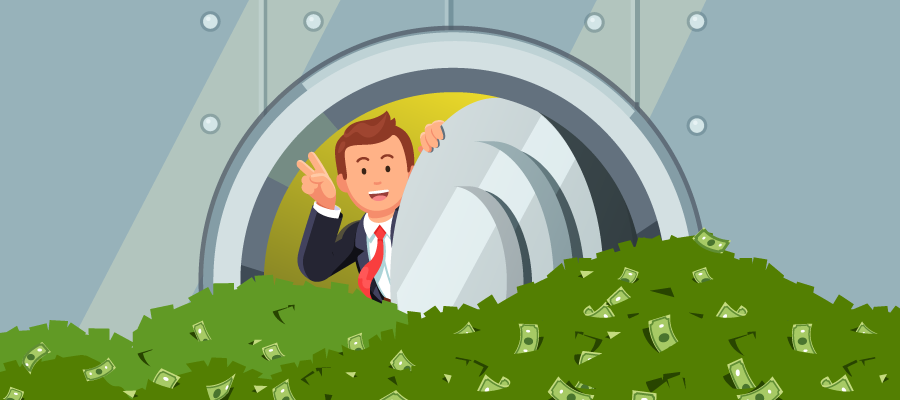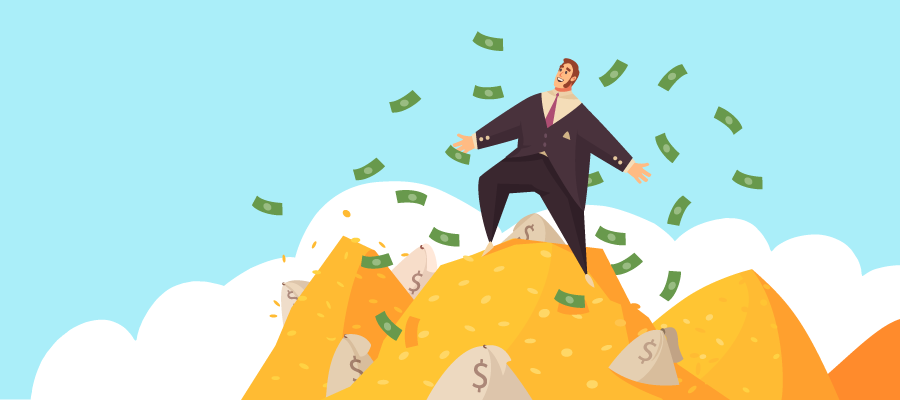One year later: Canadian billionaire wealth up by $78 billion

One year into the COVID-19 pandemic that has upended the lives of millions of people in this country, Canadian billionaires have increased their wealth by $78 billion.
Data from Forbes’ “real-time billionaires” listing on April 7 compared with a snapshot provided by their annual billionaires report last year shows this massive increase in wealth. Together, 47 Canadian billionaires now control $270 billion in total wealth.1
Among the biggest winners are the Thompson fortune ($14.4 billion increase in wealth), Tobi Lutke of Shopify ($8.8 billion increase) and BC’s Jim Pattison ($7.2 billion increase). Last year Pattison’s grocery chains, along with those of billionaire Galen Weston, infamously clawed back pandemic pay bumps for frontline workers while their profits soared.
Meanwhile, 5.5 million Canadian workers lost their jobs or had more than half of their hours cut at the pandemic’s peak. The latest Statistics Canada data show the number of jobs affected remaining at over half a million (with 300,000 fewer people employed and another 250,000 with the majority of their hours cut). Moreover, some recent job growth is likely to be reversed in response to the third wave and associated restrictions not yet reflected in the data. Low wage workers have consistently been hit hardest in the job loss numbers throughout the pandemic.
5.5 million Canadian workers lost their jobs or had more than half of their hours cut at the pandemic’s peak.
Inequality in Canada had already reached new extremes prior to the pandemic. The richest 1% controlled 26% of Canada’s wealth in 2016, according to a Parliamentary Budget Office (PBO) report. Recent academic research suggests that figure may be even higher at 29% of wealth. The Canadian Centre for Policy Alternatives has published research showing that Canada’s 87 richest families each hold, on average, 4,448 times more wealth than the typical family. Together these 87 families hold more wealth than the bottom 12 million Canadians combined.
Such extreme inequality is not only outrageous in itself, it also leads to worse overall health and social outcomes and puts a drag on economic growth.
As an alternative baseline, I also examined the difference between billionaire wealth now and the previous year’s Forbes billionaires report (a snapshot of February 8, 2019), since the main comparison with the Forbes report for 2020 (a snapshot of March 18, 2020) includes a dip in the markets early in the pandemic. Again, by this alternative measure, Canadian billionaires have done extremely well, adding at least $62 billion to their combined wealth compared to 2019.2
These levels of inequality and concentration of wealth among billionaires are not inevitable. A range of policy tools are available to rein in extreme inequality, while simultaneously raising revenue for sustained, long-term public investment in key areas after the pandemic.
Even without the pandemic Canada is facing huge challenges that require major public investment, including fixing our seniors care system, establishing a universal public child care system, investing in affordable housing and taking the aggressive action needed to tackle the ongoing crisis of climate change.
As a country, we are more than rich enough to meet these challenges. But this requires harnessing our national wealth, which all of us have a hand in creating, and directing more of it into investments for the common good. This means taking on the power of the wealthy few.
Even without the pandemic Canada is facing huge challenges that require major public investment.
One policy to help achieve this is a wealth tax on the super rich. Our recent research shows that a wealth tax in Canada would raise even more revenue than previously expected. A 1% annual tax on wealth over $20 million would raise approximately $10 billion in revenue per year, and a moderately more ambitious wealth tax could raise nearly $20 billion per year.
A wealth tax of this kind would only apply to the richest of the rich: the wealthiest 0.2% of Canadians. Together, these 25,000 households currently control $1.8 trillion of the country’s wealth.
There is enormous public support across party lines for a wealth tax. Opponents have tried to argue that the rich could simply evade it, but a growing body of economic research from leading experts tells us that a wealth tax can be designed and enforced effectively. What’s been missing is the political will, not the technical or economic means.
Existing elements of the tax system can also be enforced much more effectively if governments are motivated—or compelled by social movements—to take on the wealthy few.
There is enormous public support across party lines for a wealth tax.
Along with a wealth tax, additional tax policies to tackle inequality would include ending the costly preferential treatment of income from capital gains compared to income from work, closing numerous tax loopholes that benefit the affluent, reforming corporate taxes, implementing an inheritance tax on large estates worth over $5 million, and raising the top marginal income tax rates on the highest earners. In each case, these clear policy proposals are at the ready and could be implemented rapidly if the political will were there.
The tax system can’t solve all our problems, but it’s an important tool. To see the public will for measures to tax the rich be translated into policy, people will have to build power in other ways, including by strengthening workers’ rights and trade unions, as well as advancing a range of other policies that can more fundamentally deconcentrate economic power in our society.
The super rich will no doubt flex their economic and political power to oppose these steps. But history shows that organized people can fight back against organized money—and win. Given the major challenges we face, there’s rarely been a more important time to exercise that power.
Table 1. Canadian billionaires’ wealth during the pandemic: one year later
| Name | Forbes ranking, Mar. 2020 3 |
Wealth ($ bil), March 18, 2020 |
Wealth ($ bil), April 7, 2021 |
Change ($ bil) |
| David Thomson and family |
1 |
$39.9 |
$54.3 |
$14.4 |
| Joseph Tsai |
2 |
$12.6 |
$14.5 |
$1.9 |
| Galen Weston and family |
3 |
$8.8 |
$13.4 4 |
$4.5 |
| David Cheriton |
4 |
$6.9 |
$11.9 |
$4.9 |
| Huang Chulong |
5 |
$6.4 |
$8.5 |
$2.0 |
| Mark Scheinberg |
6 |
$6.2 |
$6.2 |
$0.0 |
| James Irving |
7 |
$5.7 |
$5.4 |
-$0.3 |
| Jim Pattison |
8 |
$5.4 |
$12.6 |
$7.2 |
| Emanuelle Saputo and family |
9 |
$4.8 |
$7.6 |
$2.8 |
| Anthony von Mandl |
10 |
$4.2 |
$11.0 |
$6.8 |
| Daryl Katz |
11 |
$4.0 |
$4.7 |
$0.6 |
| Chip Wilson |
12 |
$4.0 |
$6.3 |
$2.3 |
| Alain Bouchard |
13 |
$3.9 |
$5.7 |
$1.8 |
| Tobi Lutke |
14 |
$3.8 |
$12.6 |
$8.8 |
| Lawrence Stroll |
15 |
$3.3 |
$4.0 |
$0.8 |
| Bob Gaglardi |
16 |
$3.2 |
$3.7 |
$0.5 |
| Arthur Irving |
17 |
$3.2 |
$2.4 |
-$0.8 |
| Jean Coutu & family |
18 |
$3.0 |
$3.7 |
$0.6 |
| Charles Bronfman |
19 |
$2.9 |
$3.2 |
$0.3 |
| Mitchell Goldhar |
20 |
$2.8 |
$3.4 |
$0.6 |
| Barry Zekelman |
21 |
$2.8 |
$2.9 |
$0.1 |
| Carlo Fidani |
22 |
$2.6 |
$4.2 |
$1.5 |
| Michael Lee-Chin |
23 |
$2.5 |
$1.9 |
-$0.6 |
| Bruce Flatt |
24 |
$2.4 |
$3.4 |
$1.0 |
| Peter Gilgan |
25 |
$2.3 |
$4.8 |
$2.5 |
| Robert Miller |
26 |
$2.3 |
$2.5 |
$0.3 |
| Peter Szulczewski |
27 |
$2.3 |
$1.8 |
-$0.5 |
| Garrett Camp |
28 |
$2.1 |
$5.7 |
$3.5 |
| Jacques D’Amours |
30 |
$1.9 |
$2.8 |
$0.9 |
| Stephen Jarislowsky |
31 |
$1.9 |
$2.3 |
$0.4 |
| Serge Godin |
32 |
$1.8 |
$3.0 |
$1.3 |
| Hal Jackman |
33 |
$1.8 |
$3.7 |
$1.9 |
| Pierre Karl Péladeau |
34 |
$1.8 |
$2.5 |
$0.8 |
| Clayton Zekelman |
35 |
$1.8 |
$1.8 |
$0.0 |
| Jack Cockwell |
36 |
$1.6 |
$2.4 |
$0.8 |
| Terence Matthews |
37 |
$1.6 |
$1.8 |
$0.1 |
| Stephen Smith |
38 |
$1.6 |
$3.3 |
$1.6 |
| Guy Laliberté |
40 |
$1.4 |
$1.5 |
$0.1 |
| Mark Leonard & Family |
41 |
$1.4 |
$2.9 |
$1.5 |
| Brandt Louie |
42 |
$1.4 |
$1.6 |
$0.3 |
| Alan Zekelman |
43 |
$1.4 |
$1.5 |
$0.1 |
| Gerald Schwartz |
44 |
$1.3 |
$1.6 |
$0.4 |
| Total |
$176.9 |
$254.6 5 |
$77.7 |
Sources: Forbes’ annual billionaires list, Forbes’ “real-time billionaires” data and Bloomberg Billionaire Index. All figures shown in Canadian dollars, converted from USD using the exchange rate on April 7, 2021.
Notes
1. The total includes the wealth of six billionaires currently on the Forbes real-time list who weren’t on the annual list in 2020 (Dani Reiss, Stewart Butterfield, N. Murray Edwards, Yuan Liping, K. Rai Sahi and Apoorva Mehta). Since they were not on the 2020 list, these five are not included in the calculation of the year- over-year increase, but their wealth can still be reflected in the current billionaire total.
2. Three Canadian billionaires currently on the real-time Forbes list (Barry Zekelman, Clayton Zekelman, and Alan Zekelman) were not on the annual list in 2019. As a result, their wealth increases are not included in the calculation of the overall increase between now and 2019. Also not included in this increase figure is
the wealth increases of billionaires who are new to the list in 2021.
3. Five current billionaires are now on the Forbes real-time list but were not on the 2020 annual list (Dani Reiss, Stewart Butterfield, N. Murray Edwards, Yuan Liping, K. Rai Sahi, and Apoorva Mehta). They are not shown in the table, nor are their wealth gains reflected in the year-over-year increase estimate. Marcel Adams was on the 2020 annual list but passed away later in the year and so is not reflected on the real-time list. Aldo Bensadoun, was on the list in 2020 but is not on the real-time list and is also excluded from calculations.
4. Forbes is not currently providing a wealth estimate for Galen Weston. The April 7, 2021 figure for Weston is therefore taken from the Bloomberg Billionaires Index.
5. Total excludes five billionaires on the current Forbes real-time listing who were not on the 2020 annual list (Dani Reiss, Stewart Butterfield, N. Murray Edwards, Yuan Liping, K. Rai Sahi and Apoorva Mehta). With these included, Candian billionaire wealth total is $270 billion, as reflected in the main text.
Topics: COVID-19, Poverty, inequality & welfare, Taxes



